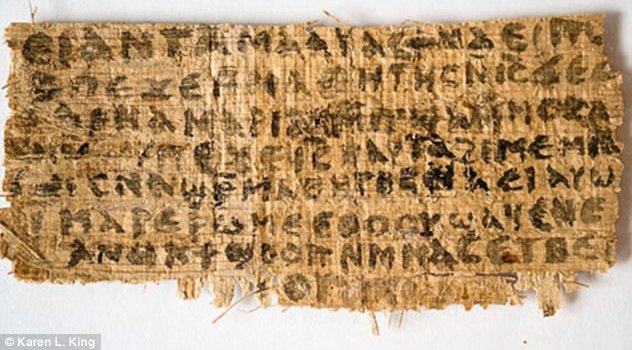In case you haven’t heard the news yet, a Harvard professor announced this week that she has found an Ancient Coptic manuscript (pictured above) which records Jesus referring to, “my wife.” Here’s the New York Times account:
A historian of early Christianity at Harvard Divinity School has identified a scrap of papyrus that she says was written in Coptic in the fourth century and contains a phrase never seen in any piece of Scripture: “Jesus said to them, ‘My wife …’ ” The faded papyrus fragment is smaller than a business card, with eight lines on one side, in black ink legible under a magnifying glass. Just below the line about Jesus having a wife, the papyrus includes a second provocative clause that purportedly says, “she will be able to be my disciple.”
We are all aware that the American media loves stories like this. Fortunately, Bible scholars who spend their lives studying this stuff are already responding. I recommend this breakdown by Peter Williams, in which he gives the whole translation, as well as all the relevant info that puts this discovery in its proper place. He ends the piece this way:
…Is it evidence that Jesus had a wife? The answer is an emphatic ‘no’. Not even Karen King is claiming that it is, though it’s inevitable that some of the news outlets will present it otherwise.
What we have here is a typical sort of text which arose after Christianity had become very popular and when derivatives of Christianity began to emerge. The language of the text is very similar to the Gospel of Thomas, sayings 101 and 114, and the Gospel of Thomas saying 101 shows influence of Luke 14:26, as the Gospel of Thomas does elsewhere. This way of speaking belongs to the mid-second century or later, in other words generations later than the books of the New Testament.
We asked Dr Simon Gathercole, an expert on apocryphal gospels and Senior Lecturer in New Testament in the University of Cambridge, for his comments. He concluded: “Harvard Professor Karen King, who is the person who has been entrusted with the text, has rightly warned us that this does not say anything about the historical Jesus. She is correct that “its possible date of composition in the second half of the second century, argues against its value as evidence for the life of the historical Jesus”.
Darrel Bock, of Dallas Theological Seminary, gives these thoughts:
-
It is a small text with no context.
-
It is a late text (4th century), if the dating given is right.
-
It would be nice to know where the text came from on the collector’s market. It is a text without any real setting right now, just a date and a few broken lines.
-
It needs a larger public vetting by experts (like being in the first quarter of a game and asking for comment on the whole).
-
What is more, in Gnostic Christianity, there was a rite called the bridal chamber in which the church was seen as the bride of Christ. The whole thing could well be metaphorical with a disciple representing the place of the church. If that is the case, then it is not even a claim that Jesus was married in real life to a single person.
-
It is one speck of a fringe text in a sea of texts that say Jesus was single. It, if authentic, is the exception, to the rule of texts we have on Jesus. Thus, in the end, even if it says what people are suggesting, it tells us only about a fourth century group’s views, not anything about Jesus.
Finally, here’s New Testament Canon expert Michael Kruger (whom I’ve been referencing here a lot):
…We do not have a single historical source in all of early Christianity that suggests Jesus was married. None. There is nothing about Jesus being married in the canonical gospels, in apocryphal gospels, in the church fathers, or anywhere else. Even if this new gospel claims that Jesus was married, it is out of step with all the other credible historical evidence we have about his life. As King herself noted, “This is the only extant ancient text which explicitly portrays Jesus as referring to a wife. It does not, however, provide evidence that the historical Jesus was married” (p. 1 here).
Everybody loves a good conspiracy theory. It would certainly be far more entertaining for our culture if one could show that apocryphal books were really the Scripture of the early church and that they have been suppressed by the political machinations of the later church (e.g., Constantine). But the truth is far less sensational…
When it comes to these sorts of questions I like to remind my students of a simple—but often overlooked—fact: of all the gospels in early Christianity, only Matthew, Mark, Luke, and John are dated to the first century. Sure, there are minority attempts to put books like the Gospel of Thomas in the first century—but such attempts have not been well received by biblical scholars. Thus, if we really want to know what Jesus was like, our best bet is to rely on books that were at least written during the time period when eyewitnesses were still alive. And only four gospels meet that standard.

